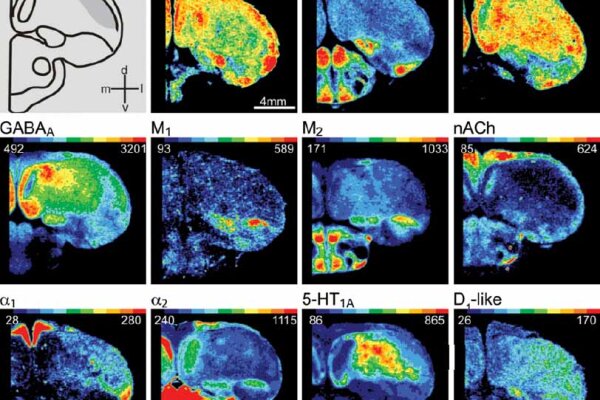2011-02-04

Mapping a territory is always the first step of analysis. So, mapping the nidopallium caudolaterale (NCL), an avian functional analogue to the mammalian prefrontal cortex, in 1993 was a prerequisite for subsequent research. However, a more comprehensive and truly comparative mapping was meanwhile needed. Therefore, scientist from the Institute of Brain Research in Düsseldorf and Biopsychologists from Bochum analyzed binding site densities of AMPA, NMDA, Kainite, GABAA, M1, M2, and nicotinic nACh, a1, a2, 5-HT1A, and D1-like receptors using quantitative in vitro receptor autoradiography. They compared the receptor architecture of the pigeons’ NCL, with prefrontal areas in rats and humans. Their findings enable a novel delineation of the avian NCL from surrounding structures and a further parcellation into medial and lateral components. Comparisons of the NCL with the rat and human frontal structures showed differences in the receptor distribution, particularly for glutamate receptors, but also revealed highly conserved features like for GABAA, M2, nACh and D1-like receptors. Assuming a convergent evolution of avian and mammalian prefrontal areas, these results support the hypothesis that specific neurochemical traits provide the molecular background for higher order processes such as executive functions.

Mapping a territory is always the first step of analysis. So, mapping the nidopallium caudolaterale (NCL), an avian functional analogue to the mammalian prefrontal cortex, in 1993 was a prerequisite for subsequent research. However, a more comprehensive and truly comparative mapping was meanwhile needed. Therefore, scientist from the Institute of Brain Research in Düsseldorf and Biopsychologists from Bochum analyzed binding site densities of AMPA, NMDA, Kainite, GABAA, M1, M2, and nicotinic nACh, a1, a2, 5-HT1A, and D1-like receptors using quantitative in vitro receptor autoradiography. They compared the receptor architecture of the pigeons’ NCL, with prefrontal areas in rats and humans. Their findings enable a novel delineation of the avian NCL from surrounding structures and a further parcellation into medial and lateral components. Comparisons of the NCL with the rat and human frontal structures showed differences in the receptor distribution, particularly for glutamate receptors, but also revealed highly conserved features like for GABAA, M2, nACh and D1-like receptors. Assuming a convergent evolution of avian and mammalian prefrontal areas, these results support the hypothesis that specific neurochemical traits provide the molecular background for higher order processes such as executive functions.